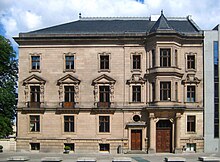Reichstag Presidential Palace
The Reichstag President's Palace is a listed building on Friedrich-Ebert-Platz in Berlin opposite the east entrance of the Reichstag building . Today it is the seat of the German Parliamentary Society (DPG).
It is part of the Jakob-Kaiser-Haus building complex used by the German Bundestag and, in addition to the Reichstag building and two older old buildings, also integrated into the Jakob-Kaiser-Haus, part of the historical building mass in the new government district in the Spreebogen .
history
The Reichstag Presidential Palace was designed by Paul Wallot , the architect of the Reichstag building, and built between 1899 and 1904 on the only undeveloped property in its immediate vicinity.
In order to enable a representative building despite the unfavorably cut and narrow site, Wallot aligned the front side of the building with the Spree, thereby gaining space for a garden and a driveway to the “Kaisersaal”, a ballroom, which is attached to the east. He placed the entrance to the living quarters of the Reichstag president on the side facade facing the Reichstag. The sandstone facades of the palace are richly structured and decorated with architectural decorations.
Until 1919, the presidents of the Reichstag used the palace , which was later destroyed by a section for servants, initially exclusively as a place to live and work. During the Weimar Republic the palace was also used as a democratic forum for political encounters and debates.
On August 30, 1932, the Nazi politician Hermann Göring moved into the palace as President of the Reichstag. The news magazine Der Spiegel reported in 1959 on the assertion by journalist Harry Schulze-Wilde that on February 27, 1933, members of the SA, with Göring's knowledge, had used a corridor from the palace to the Reichstag to set the parliament building on fire . The corridor led from the Reichstag and the Reichstag presidential palace to a nearby heating plant. During renovations in the 1990s, a pipe duct was actually exposed. Part of it was sawed out during the construction work and is now in the pedestrian underpass from the Reichstag to the Jakob-Kaiser-Haus.
After 1933, the ruling National Socialists continued to formally maintain the palace as the official seat of the President of the Reichstag, but it largely lost its former importance as a result of the disempowerment of parliament . It was in this building that Hitler's secret meeting of February 20, 1933 with leading industrialists took place. During the Second World War , the building suffered lasting damage from the effects of the war.
After the end of the war in 1945, with the exception of the eastern part of the building, the palace was repaired and used in various ways during the GDR era, including from 1949 to 1959 by the Institute for Marxism-Leninism at the Central Committee of the SED and later for a long time as the seat of the “ VEB German records ". From 1961 to 1989 the building was directly adjacent to the Berlin Wall , which ran between the Palais and the Reichstag building.
On June 20, 1991, the Bundestag decided in its capital city resolution to move the parliament and government seat from Bonn to Berlin. In 1994 the palace and the connecting tunnel to the Reichstag and the gardens were placed under monument protection by the state conservator. From 1997 to 1999 the building was restored on behalf of the Bundesbaugesellschaft Berlin under the direction of the Cologne architects Thomas van den Valentyn based on the original design. The remaining parts of the interior from the construction period were taken into account.
Seat of the German Parliamentary Society
With the move of the German Bundestag, the former Reichstag presidential palace became the seat of the German Parliamentary Society in September 1999.
To a limited extent, it also serves the Bundestag as a political meeting point and as a location for parliamentary receptions and events. After the Bundestag elections in 2005 , the Reichstag Presidential Palace came into the public eye, as exploratory talks between potential coalition partners took place in the DPG premises. The exploratory talks were also held here after the federal elections in 2013 and 2017 .
See also
literature
- Hagen Eying, Alexander Kluy, Gina Siegel (editor): Democracy as a client. Federal buildings in Berlin from 1991 to 2000 . Ed .: Federal Ministry for Transport, Building and Housing. 1st edition. Junius Verlag, Hamburg 2000, ISBN 3-88506-290-9 , p. 70-83 .
Web links
- Entry in the Berlin State Monument List with further information
- Album Palais of the Reichstag President
- pgd-berlin.de
- bundestag.de ( Memento from June 25, 2004 in the Internet Archive )
- luise-berlin.de
Individual evidence
Coordinates: 52 ° 31 ′ 7 ″ N , 13 ° 22 ′ 40 ″ E



